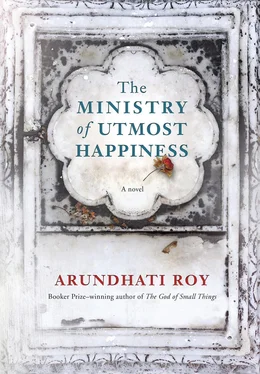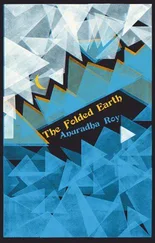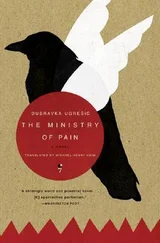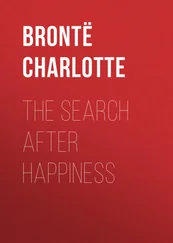The delegation trooped in and sat down on what chairs were available, some perched on the arms of the others’ chairs. Dr. Bhagat was used to seeing his patients from the Khwabgah in twos and threes (they never came alone). He was a little taken aback at the multitude that descended on him that morning.
“Which one of you is the patient?”
“None of us, Doctor Sahib.”
Saeeda, the spokesperson, with occasional clarifications and elucidations from the others, described Anjum’s altered behavior as carefully as she could — the brooding, the rudeness, the reading and, most seriously, the insubordination. She told the doctor about Zainab’s illnesses and Anjum’s anxiety. (Of course she had no means of knowing about Anjum’s sifli jaadu theory and her own part in it.) The delegation had, after detailed consultations with each other, decided to leave Gujarat out of it because:
(a) They didn’t know what, if anything, had happened to Anjum there.
And,
(b) Because Dr. Bhagat had a biggish silver (or perhaps it was only silver-plated) statue of Lord Ganesh on his table and there was always smoke from a fresh incense stick curling up his trunk.
Certainly there were no concrete conclusions to be drawn from this latter fact, but it made them unsure of his views on what had happened in Gujarat. So they decided to err on the side of abundant caution.
Dr. Bhagat (who, like millions of other believing Hindus, was in fact appalled by the turn of events in Gujarat) listened attentively, sniffing and tapping the table with his pen, his bright, beady eyes magnified by thick lenses set in gold-framed spectacles. He furrowed his brow and thought for a minute about what he had been told and then asked whether Anjum’s wanting to leave the Khwabgah had led to the Reading or the Reading had led to her wanting to leave. The delegation was divided on the issue. One of the younger delegates, Meher, said that Anjum had told her that she wanted to move back to the Duniya and help the poor. This set off a flurry of merriment. Dr. Bhagat, not smiling, asked them why they thought it so funny.
“ Arre , Doctor Sahib, which Poor would want to be helped by us ?” Meher said, and they all giggled at the idea of intimidating poor people with offers of help.
On his prescription pad Dr. Bhagat wrote in tiny, neat handwriting: Patient formerly of outgoing, obedient, jolly-type nature now exhibits disobedient, revolting-type of personality .
He told them not to worry. He wrote them a prescription. The pills (the ones that he always prescribed to everybody) would calm her down, he said, and give her a few good nights’ sleep, after which he would need to see her personally.
—
Anjum flatly refused to take the pills.
As the days passed, her quietness gave way to something else, something restless and edgy. It coursed through her veins like an insidious uprising, a mad insurrection against a lifetime of spurious happiness she felt she had been sentenced to.
She added Dr. Bhagat’s prescription to the things she had piled up in the courtyard, things she had once treasured, and lit a match. Among the incinerated items were:
Three documentary films (about her)
Two glossy coffee-table books of photographs (of her)
Seven photo features in foreign magazines (about her)
An album of press clippings from foreign newspapers in more than thirteen languages including the New York Times , the London Times , the Guardian , the Boston Globe , the Globe and Mail, Le Monde, Corriere della Sera, La Stampa and Die Zeit (about her).
The smoke from the fire rose and made everybody, including the goat, cough. When the ash cooled, she rubbed it into her face and hair. That night Zainab moved her clothes, shoes, school bag and rocket-shaped pencil box into Saeeda’s cupboard. She refused to sleep with Anjum any more.
“Mummy’s never happy,” was the precise, merciless reason she gave.
Heartbroken, Anjum emptied her Godrej almirah and packed her finery — her satin ghararas and sequined saris, her jhumkas, anklets and glass bangles — into tin trunks. She made herself two Pathan suits, one pigeon gray and one mud brown; she bought a second-hand plastic anorak and a pair of men’s shoes that she wore without socks. A battered Tempo arrived and the almirah and tin trunks were loaded on to it. She left without saying where she was going.
Even then, nobody took her seriously. They were sure she’d be back.
ONLY A TEN-MINUTE TEMPO RIDE from the Khwabgah, once again Anjum entered another world.
It was an unprepossessing graveyard, run-down, not very big and used only occasionally. Its northern boundary abutted a government hospital and mortuary where the bodies of the city’s vagrants and unclaimed dead were warehoused until the police decided how to dispose of them. Most were taken to the city crematorium. If they were recognizably Muslim they were buried in unmarked graves that disappeared over time and contributed to the richness of the soil and the unusual lushness of the old trees.
The formally constructed graves numbered less than two hundred. The older graves were more elaborate, with carved marble tombstones, the more recent ones, more rudimentary. Several generations of Anjum’s family were buried there — Mulaqat Ali, his father and mother, his grandfather and grandmother. Mulaqat Ali’s older sister Begum Zeenat Kauser (Anjum’s aunt) was buried next to him. She had moved to Lahore after Partition. After living there for ten years she left her husband and children and returned to Delhi, saying she was unable to live anywhere except in the immediate vicinity of Delhi’s Jama Masjid. (For some reason Lahore’s Badshahi Mosque did not work out as a substitute.) Having survived three attempts by the police to deport her as a Pakistani spy, Begum Zeenat Kauser settled down in Shahjahanabad in a tiny room with a kitchen and a view of her beloved mosque. She shared it with a widow roughly her own age. She earned her living by supplying mutton korma to a restaurant in the old city where foreign tour groups came to savor local food. She stirred the same pot every day for thirty years and smelled of korma the way other women smelled of ittar and perfume. Even when life left her, she was interred in her grave smelling like a delicious Old Delhi meal. Next to Begum Zeenat Kauser were the remains of Bibi Ayesha, Anjum’s oldest sister, who had died of tuberculosis. A little distance away was the grave of Ahlam Baji, the midwife who’d delivered Anjum. In the years before her death, Ahlam Baji had grown disoriented and obese. She would float regally down the streets of the old city, like a filthy queen, her matted hair twisted into a grimy towel as though she had just emerged fresh from a bath in ass’s milk. She always carried a tattered Kisan Urea fertilizer sack that she crammed with empty mineral-water bottles, torn kites, carefully folded posters and streamers left behind by the big political rallies that were held in the Ramlila grounds nearby. On her grimmer days Ahlam Baji would accost the beings she had helped bring into the world, most of whom were grown men and women with children of their own, and abuse them in the foulest language, cursing the day they were born. Her insults never caused offense; people usually reacted with the wide, embarrassed grins of those who are called on stage to be guinea pigs in magic shows. Ahlam Baji was always fed, always offered shelter. She accepted food — rancorously — as though she was doing the person who offered it a great favor, but she turned down the offer of shelter. She insisted on remaining outdoors through the hottest of summers and the bitterest of winters. She was found dead one morning, sitting bolt upright outside Alif Zed Stationers & Photocopiers, with her arms around her Kisan Urea sack. Jahanara Begum insisted she be buried in the family graveyard. She organized for the body to be bathed and dressed and for an imam to say the final prayers. Ahlam Baji had, after all, midwifed all her five children.
Читать дальше













